Friday, July 07, 2006
Os, Lyse Kloster, & Fana, July 5
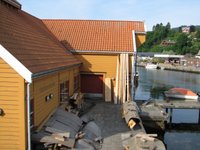


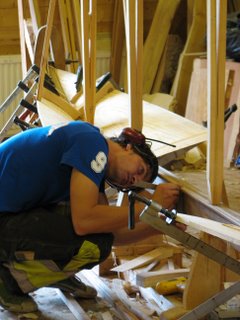


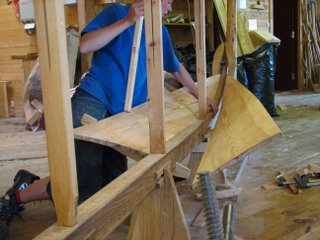



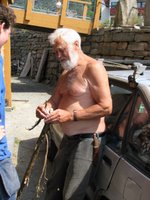
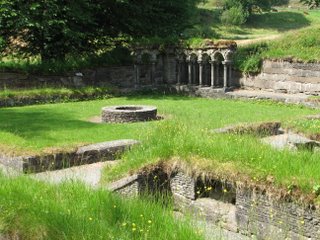

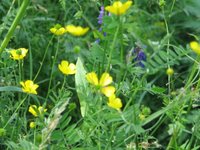
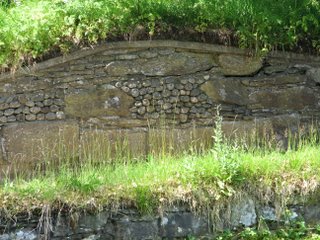
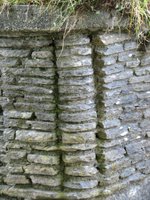
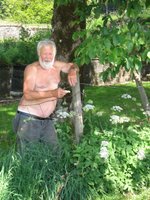
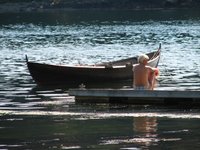
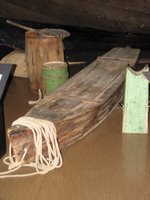

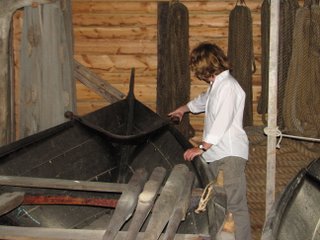
I was on the 8 am bus to Os about an hour south of Bergen to see another traditional boatbuilding workshop, the Oselvarverkstaden (Oselvar Boat Yard). I circled the building a few times because it seemed pretty still, but then a door opened. There are three apprentice boatbuilders there now, and they are each making a færving. The Oselvar færving that is being built here is very close to the Hardanger færving being built at the Hardanger Fartøyvernsenter in Norheimsund. In fact, these four-oar rowing and sail boats are very close to the ones found in on the Gokstad Ship in the Viking burial mound from the 9th century. This structure has been used for over one thousand years, and there are archeological findings of parts of these same clinker built boats up to 2000 years old.
Now they use machines to speed up certain processes, but depend largely on hand tools, especially the axe, for the most part. When they are making the "T" shaped keel out of oak, they are now making an undercut on the tablesaw at a 12 degree angle. They waste out the part under the arms of the "T" by overhanging the stick on the jointer and rabbetting out the waste. Slick trick! Get that darned guard of the jointer people!
But being a builder of traditional wooden boats in Norway still means taking a lot of care and patience in wood aquisitionand selection. We thought we took our time at College of the Redwoods, pulling every choice plank out of the wood room and carefully inspecting the color and grain figure. This is different though. They spend about 2 weeks every year up in the forest looking at trees that have the right curves, and ones that are old, slow grown, wide trees that can provide them with the very broad and tight-grained planks needed to make a boat with just 3 strong strakes. The trees are milled with a portable saw mill and the wood is brought to the boathouse. Most of the boat is pine, but the parts used for the stem and stern and keel are oak. The oak is put into a pen under the dock. It will sit there for three years, underwater when the tide is high. The Air exposure during low tide protects the wood from getting attacked by shipworms. After three years, the oak is more soft and workable, and much of the tension has been released so that the oak is very stable. It is then air dried for another year. A lot of space is dedicated to wood storage here.
Both of the apprentices working on their boats that morning were in the middle of their boats, so I could really see the process. Berit Osmundsen, a woman from the Lofoten Islands, was finishing shaping the halsen with a hand plane. Maik Riebort, a man living in Berlin who is also a film student and a dancerwhen he is not a boatbuilding apprentice in Norway, was making the flatter boards that join up the halsen. He said this is the easiest part in the whole boat.
I love seeing how the boats are built in place, and how they are braces and fixed in place with sticks from the floor and low ceiling beams pushing the boat planking into tension and compression. With this system, the builder had a lot of fine control over the exact angles and shapes the boards take. It is very practical and effective, and they do not have to sit around doing trigonometry on thier calculators (as I am prone to do).
OK, that's it! I'm becoming a boatbuilder! Get me an axe!
Another reason to become a Norwegian woodworker: the blue pants. All of the carpenters wear them here, sort of like Carhartts. But these have all of these auxillary pockets like wearing an apron, plus they have these foam insert knee pads. I told Berit that I had to have some blue pants. She happened to have a pair left by an ex-boyfriend that were the right size and price for me. We just had to find a ride to her house.
Luck would have it that a retired gentleman had stopped by for lunch. He often came to the boathouse for a little society around lunchtime. He was wearing no shirt and ratty pants. He had been fishing all morning and had four or five big fish with him. He really wanted to give me one, but I thought better of it considering I was doing a lot of riding on the bus and it was quite hot out. The man, Andor, gave us a ride to the blue pants. He thought it was a shame that I should have to take two busses and do some backtracking in order to get to my next stop, Fana, so he offered to drive me to another stop.
Well, he spoke very little english, and I speak very little norsk. I tried to understand the plan, but ended up just saying "OK" a lot. We stopped at some ruins at Lyse Kloster that are dated 1146. These are fantastic, but they are not in either of my guidebooks. Andor ransacked his cluttered car for a brochure for me while I climbed up the low, fat walls of the ruins and hopped over doorways. Like other places I have been outside the States, the ruins were no more protected from me than I was from them. That's much more fun. Some of my favorite parts were the places in the stone walls where the rack sizes were mixed up, so there would be a lot of small, flat raock and then a patch of rounded cobbles mixed in.
The only other folks around were a woman and her school-aged son. By the time I had returned from taking pictures and exploring, Andor had stuck up a conversation with this woman. He managed to get her to take a fish home.
Andor is quite a character. He is enthusiastic, friendly, generous, chatty, and hard to shake. He is a free spirit, so he sometimes drives on the right side of the road, but he likes to mix it up by driving in the middle and on the left too. The gutter is not off limits either. Between his driving style and his interest in showing me the region, I wondered if I would get to the museum where I had an afternoon appointment. But Andor did deliver me to Fana and the Horda Museum, right to the front steps. He drove right through the detour tape that had been strung tight across the road to do so. He seemed to know the people here too. He came into the museum with a warm bottle of beer and procured 2 glasses from the cafe. He still had no shirt on, by the way. We split the beer. He explained that it was the same temperature as our bodies, which was a good thing so that we would not go into shock. Right. Andor stuck around for quite a while making new friends even after I took off with the archeologist, Ole Mikal Olsen. I won't soon forget Andor.
The Horda Museum in Fana had an interesting object that I really liked: a fish coffin. It is a boat shape with open slits and a lid. It would hold live fish that fishermen were towing back to the market. The main thing that the Horda Museum houses is a large collection of old boats in storage sheds. Ole is very knowledgable about the history of these boats, and he took me around to see them. These boats were again quite similar to the ones I had seen at the boatyards, but some of these were with more pairs of oars, up to 10 oars (ti-ærving). Ove told me that in the oldest boats found, instead of having iron clinkers holding the planks together, they were actually tied with roots.
Some of the boats in the Horda collection had been used for fishing, but others had been church boats used only to go to church. These were very finely crafted with small details, and they were in mint condition due to their low milage.
Bergen, July 3-4


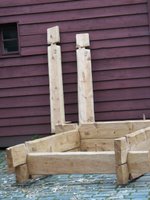
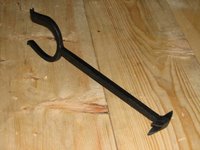







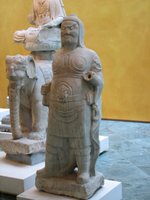
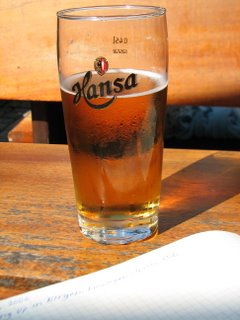 Monday morning I was ready to see more stuff. I headed to the old town part of Bergen, the Bryggen.
Monday morning I was ready to see more stuff. I headed to the old town part of Bergen, the Bryggen.This is a city block of old buildings right along the harbor that were originally built in the 12th century. The buildings were the center of the fish trade, which was tightly controlled by the Hanseatic Leauge of German merchants until the 1700s. The buildings of the Bryggen have burnt down several times over the centuries, and have been continuously rebuilt in the same way. The current structures were last built in 1702, and are being restored and preserved currently.
Alf Isak, Silje's good friend, is an architecture student in Bergen who is making the woodworking demonstrations and giving public tours in the Bryggen during the summer, and another one of their friends, Jacob, is one of the woodworkers restoring the buildings. Alf and Jacob taught me all about the old construction methods still being used here today. The restoration work is necessary because some of the pine of the building and foundations is decomposing. The rebuilding is being built almost entirely with the same types of tools and techniques as the original buildings were in 1702.
The buildings are almost entirely made of pine. The construction method is another traditional Norwegian method called "lafting". Lafting is very different than the "grindbygningen" technique I learned about in Voss. Not to simplify it too much, but lafting is more like Lincon Logs where the logs are interlocked at the building corners. The sides are hewn of a whole log with an axe to make one thick plank, a laft. This 5-6 inch thick plank includes the heartwood and the pith of one log, so it is very stable. As Alf will demonstrate, to hew the log, first notches arechopped down the length of the log, then the remaining wood is lopped off. The ends get an edge lap/ bridal joint. The work is almost entirely done with an axe; it can be very quick and accurate for a skilled worker.
There is a great trick for getting a tight fit between the lafts as they are stacked on top of each other lengthwise. After the sides are hewn off the logs, the top and bottom edges of the laft are beveled on both sides with a drawknife so that they have a pointed edge. When one laft is stacked above the last one, they rest point to point. A forked, double pronged scribe called a "me" is used to "medrag" or scribe a double line: one line on the upper laft, one on the lower. The two lines are parallel, so even though the surface will not be a flat plane, the two surfaces will match up if both lafts are trimmed to the scribe lines. I need to get me one of these medrags for all of my fitting a curve to a curve work!
Looking around, I noticed that the natural forms of curved wood were constantly being used here too. In grindbygningen, the curved parts cross brace the upright and the horizontal beams. In lafting, the point where the trunk widens and spreads into the roots is used as a corner block to support the external walkways or gangplanks cantileivered around the buildings. This particular part of the tree is called the knee of the tree, and a lot of tree's knees are being used in Bryggen.
After work, Alf joined me for a pint (.45 liters actually, a norsk pint). I think he deserved it after all of that chopping. It made me thirsty!
------------------------------------------
The Fourth of July was on a Tuesday. Seeing as it was a holiday, I slept in and spent a late morning at a cafe writing postcards. At 11:00 am I was having a coffee, but most of the people on the patio were having their norsk pints already. I guess everyone was having a holiday. I kept waiting for the city to set up bleachers and parade route detours next to the harbor, but that never happened. I visited Alf and Jacob at Bryggen again to see some more chopping. I really admire hard work; I could watch someone work hard all day long. (I can't take credit for that one, but I can't recall to whom I should give the credit.) Actually, I wanted to show them Kåre Herfindal's book which they had not seen yet. We were being wood geeks together.
In the afternoon, I visited the Vestlandke Kunstindustrial Museum. I was hoping to see some great examples of traditional or typical Norwegian wood furniture. There was a collection of period furniture with some contemporary stuff mixed in, but nothing in that exhibit grabbed me. What did catch my attention was the Chinese sculpture exhibit. I really liked the attitude and posture on this one warrior . . . sort of knock'um sock'um.
Well, I had pretty much done everything I wanted to do in Bergen. I had been hearing the Irish pub through my bedroom window for several days, and I decided it would be a good place for me to do some individual celebration of the Fourth. Skål everyone!
Bergen, July 2
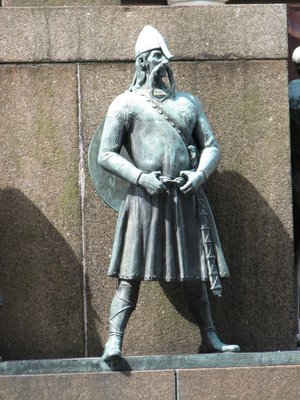
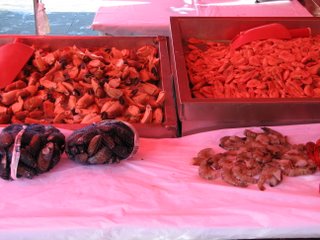
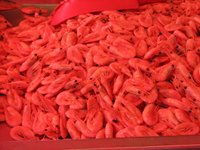

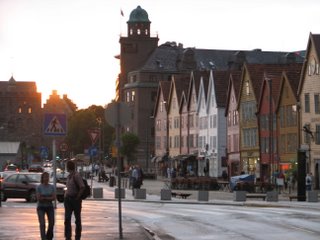

 I stayed at a friend of a friend's girlfriend's apartment in Bergen. The place is really centrally located across from the theater. It is upstairs from a falafel place and across form and Irish pub that stays very noisy until 3am. It was great to be in an apartment and have a kitchen! Thank you Silje!
I stayed at a friend of a friend's girlfriend's apartment in Bergen. The place is really centrally located across from the theater. It is upstairs from a falafel place and across form and Irish pub that stays very noisy until 3am. It was great to be in an apartment and have a kitchen! Thank you Silje!After all that I had already seen and learned, my brain was full. I spent half of Sunday wandering around Bergen like a zombie. There was a museum on my agenda, but I couldn't bear to be inside. I took the Fløibanen, the funicular railroad, up to the top of the hill and took in the birds, eye view of the harbor and the town. Bergen is a university town and a harbor town. It is a hairpin of a harbor, stretching deep and narrow right to the town center. An outdoor market with loads of fish is open everday right at the point of the harbor.
Not much else is open on Sundays in Norway. I strolled the main pedestrian street window shopping and noticing the street performers. The horn ensemble that does instrumental renditions of "Blue Moon", "When I'm 64", and "Don't Cry for Me, Argentina" is pretty darn good. The most impressive is the guy on the wood xylophone that does the full orchestral version of the theme to "Star Wars". Here are some photos of Bergen at 10:30pm (midnight sun).
Thursday, July 06, 2006
Voss, June 30 - July 1



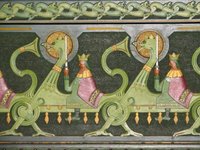
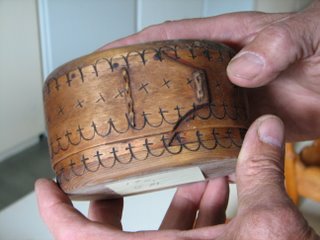











I happened to arrive in Voss in the midst of Norway's "Extreme Sport Week". That was obviously not what I had in mind . I got of the bus woozy and hot to find the banks of the fjord crowded with tents, college students, and parachute landing sites. In the tourist office, there was a group of American guys claiming to be making a TV pilot episode and trying to find out where they could get a whole sheep's head to eat. Nice.
That night as the porch and the lobby filled with college aged kids holding bags of beer, I was having my doubts. I wondered what I was doing in Voss. I wondered what I was doing in general that had me staying in a youth hostel dorm room. The first question was answered when I got to see who and what I was there to see the next day. (The second question still stands.)
After my scandinavian smorgasbord breakfast at the hostel, I headed up the hill to the Magnus Dagestad Museum. Magnus Dagestad (1865-1957) was the star student of Lars Kinsarvik (Lars from yesterday, remember?) Magnus Dagestad, like Lars Kinsarvik, embraced the idea of developing and promoting the new style of Norwegian folk art. He mainly made furniture that was either carved, or painted in the tradition of Norwegian rosepainting (his wife was conveniently a skilled rosepainter), and some of his work was both carved and painted. The patterns seem in between the structured graphic quality of celtic knots and the organic flowing quality of art nouveau. The figures seem pretty contemporary in style based in modern, clean shapes.
Next on the agenda was the real reason I came to Voss: finding Kåre Herfindal, an expert on the many wood traditions of this region in Norway. I had had only the briefest phone call with Kåre the day before. Maybe it was a language barrier. This time I tried speaking Norwegian.
"Hei Kåre! Jeg heter Ashley. Hovrdan har du det?" Hi Kåre! My name is Ashley. How are you?
He said fine.
"Kan jeg kommer til ditt hus nå? Jeg vil gjerne se lagging og sveiping."
He said "Ja" I could come to the house.
"Det er bedre å komme i taxi eller å gå?" When I asked him if it was better to come in a taxi or to walk, he started speaking in perfectly good english and said he would come get me in his car. It turns out that he didn't realize that I was the same person that had been emailing him; he was expecting a man.
Kåre Herfindal has been teaching at the Vestnorsk Kultur Akademi. He is semi-retired, but it sounds like they won't let him quit. We went by the school workshop first where there were a few examples of student work left from the semester. These were small bentwood boxes that are made by "sveiping". These are a lot like the Shaker bent wood boxes, but instead of being nailed together, these are sewn together using the thin roots of birch gathered from a swampy bog where the tree roots are more exposed.
The traditional way to sew the boxes is to sew them right where the two ends overlap, sewing perpendicular to the grain. He and his students have begun to push this tradition with some more modern, curved edge ends to the boards with curved stitch patterns following those edges.
Right next door to the school workshop is the Vestnorsk Kultursenter and Kulturmagasinet where 15 artists/craftspersons have a common workshop. One of those craftsmen is an englishman named Keith Barker. Keith is an exuberant chairmaker and he was working that Saturday. Keith tries to keep his chairs strong and light by having the back leg come up at an angle to the chair. He had a really clever jig for gluing up a chair side that is great if you have a lot of different angles in a single plane. Keith says "Hello" to Wendy Mayumara and to Garry and Sylvia Bennett. I am encouraging Keith to join the Furniture Society.
Keith and Kåre looked at some pictures of my work. This sparked an interesting discussion about whether my work was particularly American. Keith thinks that to get away with making the kind of stuff that I make, it is very advantagous to be an American woodwork, unbound by tradition, in an American market with more open-minded and decisive buyers. It is hard enough to pedal studio furniture, but apparantly it would be harder in Europe. Keith feels that the audience would be confused by objects that are to far from the roots of a tradition. Well, that's the first good thing about being American so far! Keith has a point. Look at how the students and Kåre have pushed the tradition of sveiping. It is still 99% grounded in the classic form. I told Kåre maybe someone could really push sveiping by using that technique in a cabinet or something. He said "Maybe you!" and we all had a laugh.
There were some examples of "lagging" at the school too. Lagging is like coopering, using staves to make a barrel. These are tapered cone sections, and are used for beer barrels and pitchers. The most interesting part is the way they are held together by a hoop made from a plyable root or branch that has notched scarf joints cut in the ends. The hoop locks together, and then cinches itself tighter as the hoop expands from being shoved down the tapered cone. This might be difficult to visualize, sorry!
Kåre showed me a building on the grounds that has been constructed in the traditional "grindabygg" technique. Archeological sites show evidence of this type of construction going back 4000 years. Talk about tradition! This is a post or frame type of construction. There are corner braces made from naturally curved pieces of wood. Having a curved brace instead of a straight piece at a 45 degree angle actually makes the house more durable by making it less stiff and more flexible in strong wind, much like how the curved parts make the wooden boats strong and flexible.
Kåre happens to also be an expert in "naturformer i tre", the natural forms in wood. The use of natural, grown curves in wood is pervasive in Norwegian woodworking. I am seeing it in the sleds, the boats, the buildings, and in small objects too. We went back to Kåre's house to see many examples of smaller objects from a tree's natural form. Bowls and øl kjenge would be made from the burl, while spoons, clamps, and all sorts of things can be made from the fork between the trunk and the branch.
One last very Norwegian technique that Kåre is (guess what!) an expert in is kolrosing. Kolrosing looks a bit like skrimshaw. A drawing is made by scribing into the wood with a knife. The fine line is nearly invisible until powdered birch bark is rubbed into the cut, darkening the lines. This is sealed with oil, and then sanded to knock down the burr from the knife cut. It would suck if you had accidently scratched the wood without knowing it, because those marks would show up along with the rest. It is like invisible ink being exposed. In fact, kolrosing is used on these joined wedding spoons. The spoons and the chain that links them together are carved from a single piece of wood and then inscribed with decorations. The decorations remain invisible until the bride and groom both eat pudding from the same bowl with these spoons, and the fat in the pudding darkens the lines. Presto magic!
Well, Kåre Herfindal is awesome and I now have his book, "Handverks-Teknikkar i Tradisjon of Fornying: Sveiping, Kolrosing og Bruk av Naturformer i Tre". It is written in ny-norsk, as if trying to read in norwegian wasn't enough of a challenge. I'm on page 2. Great photos though!